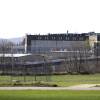There's a curious link between today's story on the imminent demise of the US's venerable U-2 spy plane and the history of Siberia's Lake Baikal, the largest fresh water lake in the world. And I stumbled upon it when I was traveling in Siberia.
When I first visited Lake Baikal, in 2000, I traveled to it from the nearby city of Irkutsk along a road as straight and smooth as all the others in the region were twisted and rutted. A road of this quality was so unusual in the region that I just knew there was something special about its construction, something that almost certainly had nothing to do with the government wanting to improve access to Russia's great inland sea for ordinary Soviet citizens.
The fact that the benefits of its missile-like trajectory were nearly outweighed by its stubborn refusal to concede an inch to the topography of endless, treacherous hills only added to my suspicion that someone had just decreed that this road be built.
A little digging around confirmed my hunch, but the details were almost laughable.
In 1960, at the height of the cold war, President Eisenhower planned what would have been a landmark visit to the Soviet Union. And between Washington and Moscow, he scheduled a stop at the glorious provincial city of Irkutsk and its even more glorious neighbor, Lake Baikal.
Problem was, there was no quick and direct route over the 60 kilometers from the city to the lake. So Moscow commanded that one be built. And it was, in just two months.
Then, just before the trip, the Soviet Union shot down the American U-2 flown by Gary Powers. Eisenhower’s visit was off. No stop in Irkutsk or Baikal. No swift and pleasant excursion for the president on the brand new road.
But, of course, the road remains — an unintended gift to the people of the region and the visitors who would eventually come many years later, after the long-delayed opening to the West.
Peter Thomson is the author of Sacred Sea: A Journey to Lake Baikal.
From PRI's The World ©2015 Public Radio International



